'Viajo hacia el interior de los materiales'
- Desde que murió Lucian Freud, es la artista británica viva más importante
Desde la muerte del pintor Lucian Freud, a Rachel Whiteread la han tasado como la artista británica viva más importante. Y no lo ha hecho su marido, sino el crítico de arte de 'The Guardian'. Es la primera mujer en conseguir el Premio Turner de arte contemporáneo, lo obtuvo en 1993 por 'House', una escultura de hormigón y aluminio que daba la vuelta al revés a una casa victoriana del este de Londres. Fue erigida en un lugar en el que había existido una fila de este tipo de viviendas, pero el ayuntamiento de Tower Hamlets la derribó en 1994, y 'House', que no iba para arte efímero, ya sólo existe en fotografías y en el recuerdo de quienes la admiraron.
Antes de girar al revés una casa, en 1990 Rachel dio la vuelta a una habitación, 'Ghost' (Fantasma), adquirida primero por Charles Saatchi y luego por la National Gallery de Washington, donde se expone de forma permanente. En 'Ghost' la artista convierte el espacio abierto y fantasmagórico de una habitación en un bloque de hormigón cerrado y compacto. ¿Qué habrá dentro? El contorno de la chimenea, de puertas, ventanas e incluso la impresión de la clavija de la luz o de un clavo que pudo sostener un retrato de antepasados o un calendario. Y con ello, las vidas que habitaron el espacio, sus voces y sus silencios. Este es el tipo de trabajo que la dio a conocer como parte del YBA (Young British Artists) aunque ella nunca se columpió en la cuerda de los famosos del grupo. En el año 2000, el monumento al Holocausto erigido en el centro de Viena, una sombría escultura de hormigón en homenaje a 65.000 judíos, la consagró fuera de Gran Bretaña.
Más de 20 años después de 'Ghost' y 'House', Rachel presenta en la galería Gagosian de Londres sus últimos trabajos; barracas volteadas como un calcetín, como las esculturas que la dieron a conocer, y también otros trabajos en los que explora el misterio que encierran los materiales. "Mi trabajo es un viaje hacia el interior de los materiales y de la experimentación con ellos; es un viaje que no tiene fin", cuenta junto a una de las chozas de hormigón que tarda varios meses en fabricar con la ayuda de hasta seis personas. "El molde lo hago yo sola, pero en las fases posteriores necesito ayuda porque acaban pesando varias toneladas".
Junto a las voluminosas esculturas de hormigón y aluminio hay todo un abanico de piezas pequeñas; una caja de bronce que parece de cartón, un bote de cristal que parece de hojalata, una puerta de resina que parece de cristal. No es un engaño, está hecho adrede, según explica la artista: "Lo hago como un juego que es parte de mi trabajo, intento que los objetos parezcan lo que no son porque lo que me interesa es la naturaleza de los materiales que utilizo, ahora, con las puertas de resina lo que más me interesa es la claridad y transparencia del material". Y para ello cada puerta tiene un color como insinuación y diferencia. Estas puertas que por su silueta se notan antiguas datan del siglo XIX y del XVIII, pero la investigación histórica la tiene sin cuidado a esta mujer a quien lo que le interesa es traspasar hasta los poros de la madera centenaria a un nuevo material.
Sobre el origen de las puertas moldeadas dice: "Las sacamos de unas obras de unos conocidos que se arreglaban la casa y entre los desperdicios de la construcción estaban las puertas; yo no investigo ni estudio su origen histórico, todo lo saco del medio que me envuelve y de lo que tengo a mi alrededor". Y de ahí se va hacia la abstracción como en la serie 'Untitled' ('Sin título') de hojas de plata y cartón sobre papel, enmarcadas para colgar en la pared.
El estudio de Rachel es una sinagoga reconvertida en el este de Londres, la ciudad en la que nació en 1963 y en la que ha expuesto su obra en los escaparates más relevantes del arte. En 2005 llenó la sala de turbinas de Tate Modern con esculturas de cajas en un momento de su vida en que vivía rodeada de cajas por un cambio de casa y por haber vaciado la vivienda de su madre tras la muerte de ésta. Fue la tercera artista que ocupó el cuarto pilar de Trafalgar Square con la obra 'Plinth' (Plinto), una estructura cuadrada, vacía y transparente que encajaba simétricamente con el pilar de la céntrica plaza a la que asoma la National Gallery que, como el Prado español, guarda el arte clásico del Estado.
La sutileza de combinar cristal con hojalata, la transparencia de la resina o la unión de bronce con cartón constituyen desafíos paralelos al volteo de chozas en las que trabaja actualmente. "Tengo un encargo de dos piezas grandes para Los Ángeles en la línea de las barracas", explica la artista para quien la diversidad de las dimensiones -de los metros de hormigón a los centímetros de celuloide o un trozo de hueso con capa de plata- resultan un reto. "Los trabajos de pequeñas dimensiones los hago en solitario, me resultan igual de estimulantes, pero no necesito la ayuda de nadie porque los manejo yo sola; los de grandes dimensiones, me resulta más complicado".
See the First Pictures of Rachel Whiteread’s Governor’s Island Installation
It's her first New York installation in 18 years.
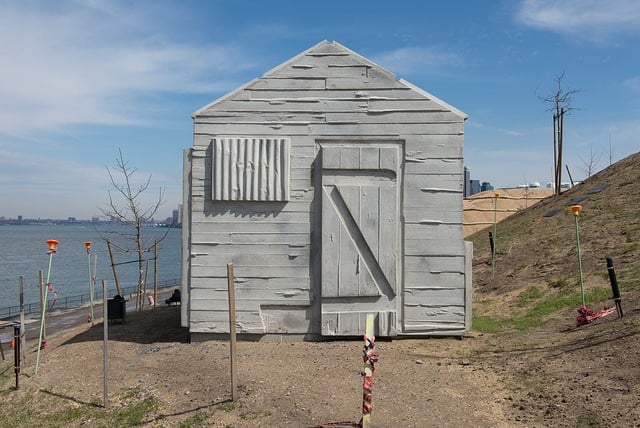 Photo by Tim Schenk
Photo by Tim Schenk
A much anticipated highlight of the soon-to-be-completed new park on Governor’s Island, the Hills, is a permanent, site-specific installation by British art star Rachel Whiteread.
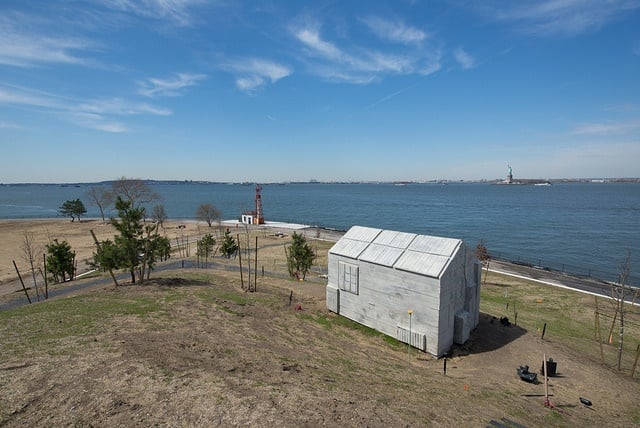 Photo by Timothy Schenck
Photo by Timothy Schenck
Cabin, as the work is known, is a concrete reverse cast of a wooden shed which was installed on the island in 2015 and is set to debut to the public next month when the park opens. The park’s completion date was bumped up from spring 2017.
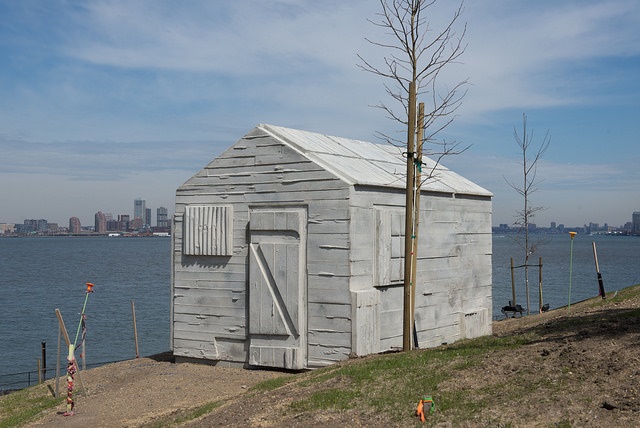 Photo by Timothy Schenck
Photo by Timothy Schenck
Whiteread’s cast sits on Discovery Hill, one of four hills in the park that are described as offering “lush rolling landscapes, grassy overlooks, exhilarating slides, [and] unforgettable views.” The island’s newest park was designed by Dutch architecture firm West 8. Cabin was first announced in April 2014, and was initially set to be installed last summer.
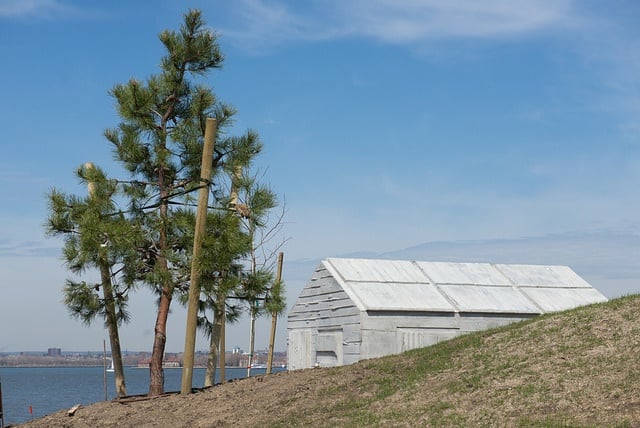 Photo by Timothy Schenck
Photo by Timothy Schenck
Cabin will reportedly be surrounded by bronze casts of actual trash found on Governor’s Island. The work continues Whiteread’s theme of reverse casting large structures and objects, previously seen in what is perhaps her most famous work to date, House (1993), a reverse concrete cast of an entire condemned Victorian house in East London that was demolished after 11 weeks. The work scored Whiteread the Turner Prize that year.
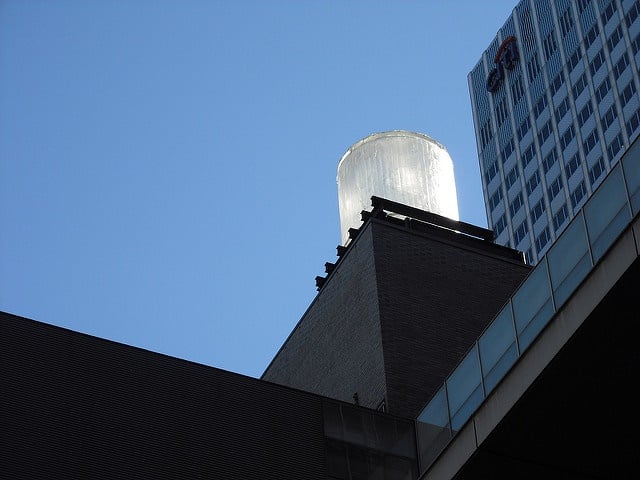 Rachel Whiteread’s Water Tower (1998) at the Museum of Modern Art. Photo: Courtesy of smokeghost via Flickr.
Rachel Whiteread’s Water Tower (1998) at the Museum of Modern Art. Photo: Courtesy of smokeghost via Flickr.
The Governor’s Island installation is Whiteread’s first public art installation in New York since 1998, when Water Tower, a clear, resin cast of a signature Manhattan rooftop water tower was originally placed atop a roof in Soho.
This past fall, Whiteread had concurrent shows at the Bushwick and Chelsea branches of Luhring Augustine Gallery, which represents her.
Art CommisionsGI, which is curated by Tom Eccles, executive director of Bard College’s Center for Curatorial Studies, invites contemporary artists to create site-specific works that respond to the island’s unique vantage point on the New York harbor, including the spectacular view of the Statue of Liberty. In 2014, Mark Handfordth and Susan Philipsz were the first artists to create commissioned work for for the program.
BIOGRAPHY OF RACHEL WHITEREAD
Childhood
Born in Ilford in Essex, Rachel Whiteread moved to London when she was seven. Her mother, the artist Patricia Whiteread, was involved in important exhibitions of feminist art at London's Institute of Contemporary Arts in the 1980s. Consequently, Whiteread and her older twin sisters grew up surrounded by art and materials for art making. Her father Thomas, a geography teacher, supported his wife's artistic career, and converted part of their house into a studio, where Whiteread remembers helping to install a concrete floor as a child. The artist has frequently cited the importance of her upbringing to her later artistic practice, feeling a particular debt to her geographically minded father, "whose interest in industrial archaeology enabled me to look up" and appreciate concepts of architecture, spatiality, and memory.
As a child, Whiteread was sent to a progressive public school, which she remembers as "awful [...] but I kind of loved it; it was a big world soup, fights all the time, influxes of Bangladeshis, Greeks, Turks, Romanians, a really interesting bunch of people all thrown together. I wasn't good at school. I didn't behave or sit down, I mucked about, doing what I could do to get by."
Early Training and Work
After school, Whiteread studied fine art on a foundation course and then painting at Brighton Polytechnic. While she was at Brighton, she studied under British sculptor Richard Wilson, who taught her the casting technique that would be so vital to her later career. She applied for courses in both painting and sculpture at London's Slade School of Fine Art, and chose sculpture, revealing later that "I couldn't make things stay on the wall ... they always ended up on the floor". At the Slade her tutors included Alison Wilding and Phyllida Barlow, two highly revered sculptors working today.
By the time she graduated in 1998, Whiteread had hit upon her signature style, casting the negative spaces inherent in everyday objects. The year after she graduated, Whiteread had her first exhibition at a small London gallery, where she showed just four pieces. These included casts of the interior of a wardrobe and the space underneath a bed, works which marked the beginning of her mature period.
At this time, she was living in East London and her a studio was part of a large complex in Carpenters Road in Stratford. She remembers her time there fondly, but recalls that the area was quite run-down at the time: "There were a few of us: Grayson Perry, Fiona Banner, Fiona Rae, Simon English. It was a sort of silent club: if you could survive Carpenters Road, you could survive anywhere. It was the Badlands."
Although Whiteread knew other artists of her generation, she always felt separate from them due to her lack of interest in being in the media: "People like Grayson Perry, who I shared a studio with back when he was still struggling, great show-offs who want to be in the media all the time... It's not for me."
Mature Period
Whiteread's self-assurance in her own practice (which has changed remarkably little in the last 30 years) is perhaps what helped her to become well known and respected relatively quickly. In 1990, at the age of 27, Whiteread created her early masterpiece Ghost at London's Chisenhale Gallery, and was subsequently nominated for the Turner Prize. In 1992, one of her pieces was selected for the prestigious Documenta IX exhibition. She was also included in exhibitions of work by Young British Artists such as Damien Hirst and Sarah Lucas, even though she was not generally a part of that group.
The following year, Whiteread produced arguably her most important - and certainly most debated - work. Untitled (House) was a cast of an entire Victorian terraced house in London's East End that had been scheduled for demolition. The work, which was shown in situ, caused huge public controversy, and became a symbol of "contemporary art" in the press (for those both for and against it). Some critics loved it, but a petition for its removal received a large number of signatures. Whiteread recalls that it was very unusual for the general press to be interested in contemporary art at the time: "You have to remember, it wasn't like it is now, with art being this rock 'n' roll thing with the media."
Whiteread was awarded the Turner Prize in November 1993 (the first woman ever to achieve this), but the local council ruled that Untitled (House) should be destroyed on the same day. Whiteread was also awarded £40,000 for being the "worst artist of the year" by the K Foundation ¬- a pop music duo whose career had made them enough money to burn - who claimed they would set light to the cash if she didn't accept it. Whiteread found the whole process stressful and ended up accepting it and then giving most of it away. In January 1994, House was destroyed; the contractor chosen to carry out the task claimed "'It's not art, it's a lump of concrete." The art world, however, was outraged, seeing Untitled (House) as an important milestone in contemporary art.
In 1995, Whiteread's work was shown as part of the British Pavilion at the Venice Biennale.
In the same year, she was awarded a commission to produce a memorial to the holocaust in the city of Vienna. As part of the planning and fabrication process, the artist travelled in Germany and Eastern Europe to sites where Nazi atrocities took place and to cemeteries and battlegrounds, deepening her understanding of the issues. Due to the political and sensitive nature of the commission, it took five years to come to fruition, but it also led to a series of public and institutional commissions for Whiteread from around the world.
In 1999, Whiteread and her partner - the sculptor Marcus Taylor - bought a former synagogue in Bethnal Green, London, which had most recently been used as a place for storing textiles. Whiteread spent several months using her casting method to get to know the building and its architectural elements. In the years that followed, the area became fashionable, partly due to the influx of artists and designers during the early 2000s. Whiteread and her partner later moved away, but when asked if she felt guilty about adding to the area's gentrification, she replied: "Guilty! For changing Shoreditch? No. We bought a weird building that had been empty for years, and it took people like us to work out a way of living there."
In 2003, Whiteread was pregnant with her first son, Connor, when her mother unexpectedly died after a routine operation. Whiteread and her sisters waited a year before they felt able to go through their mother's possessions. It was this experience of encountering boxes of objects and images from her childhood that inspired her to make a series of works based on cast boxes, including her huge 2005 Tate Modern installation Embankment.
Current practice
More recently, Whiteread has cut down her studio size and is working with fewer assistants. Consequently, her recent work has been on a smaller scale than the earlier monumental pieces from the 1990s and early 2000s.
In 2007, she gave birth to her second son, Tommy. After this event, Whiteread began to introduce more color into her work, where white, grey and organic colors had previously predominated. Some of these works include translucent resin casts of windows and doors. She has also taken on a number of commissions creating casts of small sheds for locations including London, New York, and Norway.
The Legacy of Rachel Whiteread
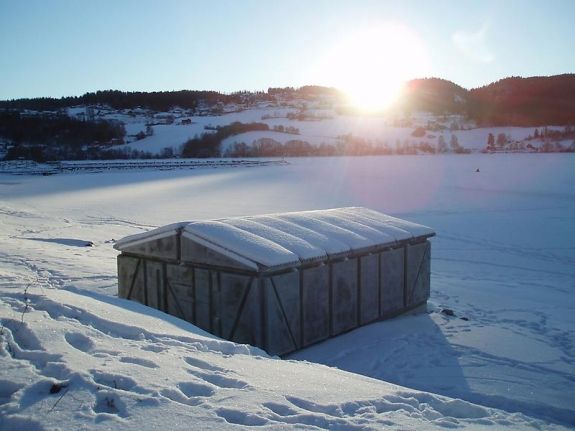
Rachel Whiteread is one of Britain's leading contemporary artists. As the first woman to have won the Turner Prize, Whiteread is an important figure for many contemporary female artists especially in having developed a way of working that is not focused on women's issues or on an explicitly feminist view point - indeed the industrial scale and materials of many of her sculptures takes any consideration of her work beyond any reductionist reading around gender.
Whiteread's remarkably consistent use of the casting method has changed perceptions of how an artist can create variety within their practice; rather than experimenting with different media, she has used the same basic method to push the media of plaster and resin to their limits. In her work she continues to experiment with ideas around space, perception and memory creating, through allusion and suggestion, pieces that have a highly emotional and sometimes political content. Although not an actual part of the group, Whiteread's loose association with the Young British Artists movement also meant that she is part of a key legacy that would influence British art for several years.
Instalación publica
Rachel Whiteread
Nissen Hut
Inauguración el miércoles 10 de octubre de 2018
Dalby Forest, Yorkshire, Inglaterra
www.forestryengland.uk
Dalby Forest, Yorkshire, Inglaterra
www.forestryengland.uk
Esta escultura de Rachel Whiteread es un molde de hormigón de una choza de Nissen, una estructura militar inventada durante la Primera Guerra Mundial, ubicada en medio del bosque de Dalby en Yorkshire, Inglaterra. Co-comisionado por 14-18 NOW y la Comisión Forestal Británica, la escultura es parte de una serie de eventos que marcan el centenario del fin de la Primera Guerra Mundial.



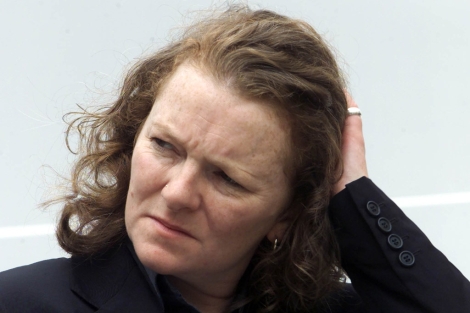

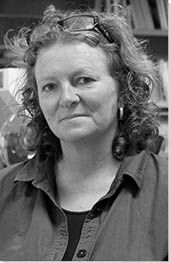
No hay comentarios:
Publicar un comentario